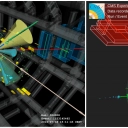
Today, at the Moriond conference, the ATLAS and CMS collaborations have both presented the observation of a very rare process: the simultaneous production of four top quarks. They were observed using data from collisions during Run 2 of the Large Hadron Collider (LHC). Both experiments’ results pass the required five-sigma statistical significance to count as an observation – ATLAS’s observation with 6.1 sigma, higher than the expected significance of 4.3 sigma, and CMS’s observation with 5.5 sigma, higher than the expected 4.9 sigma – making them the first observations of this process. The top quark is the heaviest particle in the Standard Model, meaning it is the particle with the strongest ties to the Higgs boson. This makes top quarks ideal for looking for signs of physics beyond the Standard Model. There are a variety of ways to produce a top quark. Most commonly, they are observed in quark and antiquark pairs, and occasionally on their own. According to Standard Model theory, four top quarks – consisting of two top quark–antiquark pairs – can be produced simultaneously. The rate of production is, however, predicted to be 70 thousand times lower than that of top quark–antiquark pairs, which makes four-top-quark production elusive. Evidence for this phenomenon has previously been found by ATLAS in 2020 and 2021, and by CMS in 2022. However, until today, there had never been an observation. As well as being rare, four-top-quark production is notoriously difficult to detect. When physicists search for a particular event, they look for its “signature”: the properties of the final particles of a decay. These provide clues to the short-lived events they are looking for. Every top quark decays into a W boson and a bottom quark. The W boson can then decay into either a charged lepton and a neutrino or a quark–antiquark pair. This means that the signature of four-top-quark events can be highly varied, containing from zero to four charged leptons and up to 12 jets produced by the quarks. This makes looking for the signature of four-top-quark production challenging. To help search for these events, both ATLAS and CMS used novel machine-learning techniques to build the algorithms that select four-top-quark candidate events. The analyses use the spectacular four-top-quark signature with multiple electrons, muons and (bottom-quark-tagged) jets to separate the events with four top quarks from the background due to other Standard Model processes with larger production rates. Both ATLAS and CMS searched for event signatures containing two or more leptons. The first direct observation of four-top-quark production is an exciting new step in learning more about this fascinating particle. Both experiments look forward to continuing to study this phenomenon during LHC Run 3. Read more: ATLAS physics briefing CMS physics briefing
 Stephen Sekula
Stephen Sekula
 Stephen Sekula
Stephen Sekula
 Stephen Sekula
Stephen Sekula
 Stephen Sekula
Stephen Sekula
 Stephen Sekula
Stephen Sekula
